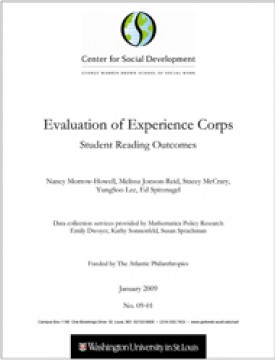Experience Corps Shows Improvement in Reading Scores
Resource type: Evaluation
Center for Social Development |
Experience Corps, which pairs older adults in the United States with students who are struggling in school, showed statistically significant improvements in reading outcomes and was positively viewed by teachers, according to this evaluation commissioned by The Atlantic Philanthropies. Experience Corps is an Atlantic grantee.
The Experience Corps (EC) program brings older adults aged 55+ into public elementary schools to tutor and mentor children who are at risk of academic failure. The EC program began in 1995 in five cities and has grown to include 23 sites. Currently, there are nearly 2,000 EC tutors serving approximately 20,000 students. Older adults are recruited to serve in this program and receive training to prepare them for their service assignments, focused on literacy and relationship-building. Each Experience Corps volunteer, or “member,” is assigned as part of a team to a local elementary school participating in the program. At the beginning of the school year, teachers refer low-achieving students to the program; and EC members begin regular tutoring with the children.
In 2006, researchers at the Center for Social Development at Washington University’s Brown School of Social Work were awarded a grant from The Atlantic Philanthropies to evaluate the effects of the Experience Corps program on student reading outcomes. Mathematica Policy Research, Inc. (MPR) provided data collection services.
Twenty-three schools in Boston, New York City, and Port Arthur, Texas, participated in the study. A two group, pre-post test design with random assignment was used to assess the effects of the EC program. At the beginning of the school year, teachers referred all students who needed assistance with reading. Students were randomly assigned to the EC program, as there were not enough tutors to serve all of the referred students. Over 1,000 students were referred. Parental consent was obtained on 81% of the referred students, and 883 students were pretested. At posttest, 825 students were reassessed. The EC program tutored 430 of these students, and 451 were in the control group. There were 332 1st, 304 2nd, and 186 3rd graders; 420 males and 402 females in the final dataset.
Data for the study came from three sources: interviews with the students; assessments completed by teachers; and school records. MPR interviewers assessed reading ability at the beginning and end of the school year in face-to-face interviews with the students. Standardized reading tests were used: the Woodcock Johnson word attack subscale (WJ-WA), the Woodcock Johnson passage comprehension subscale (WJ-PC), and the Peabody Picture Vocabulary test (PPVT-III). These widely used measures were chosen because they were not specific to any one of the tutoring curricula used in the participating EC programs, but there was some correspondence between skills assessed by the standardized measures and aspects of the various programs’ curricula. At the beginning and end of the academic year, teachers completed assessments of grade-specific reading skills and classroom behavior. At the end of the year, school records were abstracted to ascertain demographics and other student characteristics, and tutors rated the quality of their relationships with the EC students as well as provided their perceptions of student progress.
Analysis of pretest data showed that the EC students and control groups were equivalent on all measured characteristics. Students referred to the EC program were very poor readers and were clearly in need of assistance. From the scores on the WJ-PC measure, we can conclude that half of the students referred to EC perform as low as or lower than 84% of the students their age nationwide, and 12% score worse than 97% of the population.
The EC program succeeded in delivering the intervention to a large number of the students identified for the program. About half of the EC students received 30 to 49 sessions, and the mean number of sessions was 45. Three-quarters of the students received over 35 sessions, which represents about one session a week throughout the program period.
The students in the EC program made statistically greater gain over the academic year on passage comprehension and on assessments of grade-specific reading skills made by the teachers (p < .05); and the group difference on word attack was marginally significant (p < .07).
In general, the effects of the program were consistent across subgroups of students. That is, the program impact was the same no matter what the gender, ethnicity, grade, classroom behavior, or English proficiency of the student. However, it is important to note that special education students, operationalized as those with IEPs in the student record, did not benefit from the EC program as much as non-special education students in regards to reading comprehension. EC programming with special education students needs to be reconsidered in light of this finding.
When including only the EC students who received at least 35 sessions, a criterion that we chose to indicate that the students received the intervention as intended, the effects were stronger. The effect sizes associated with the improvement in reading outcomes were .13 to .17.
Teachers overwhelmingly rated the EC program as beneficial to students, and they found that it had no or low burden to them. Tutors perceived that the EC program had a positive impact on students, and their relationships with students were good. Further, tutor relationship was related to reading outcomes, with better relationships associated with better outcomes.
In sum, these findings indicate that the EC program had statistically significant and substantively important effects on reading outcomes.
Read a statement by Experience Corps CEO Lester Strong.
